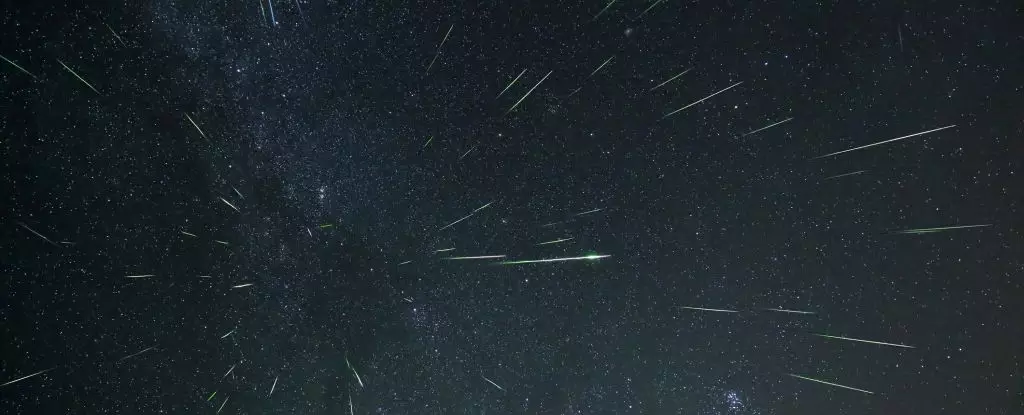As all keen skywatchers know, the months of April and May usher in two stunning meteor shower events that are simply too remarkable to miss. With the Lyrid meteor shower from April 17 to April 26, peaking on the nights of April 21 and 22, and the Eta Aquariids lighting up the heavens from April 20 to May 21, with its peak on May 2 and 3, the sky will soon be transformed into a dazzling display of cosmic phenomena. Prepare yourself for an exhilarating experience that demands only your presence and an open sky; no telescopes or fancy equipment are necessary—just your own eyes and perhaps a warm blanket.
Understanding Meteor Showers: A Cosmic Dance
Meteor showers represent one of nature’s most captivating displays. They occur when Earth traverses through debris left behind by comets and asteroids, fragments that enter our planet’s atmosphere and burn up, creating brilliant trails of light. The remnants that cause these stunning light shows are bits and pieces of cosmic history, remnants of celestial bodies like comets that have long since passed their prime, yet continue to leave their mark on the universe’s canvas.
The upcoming Lyrid meteor shower, linked to the comet C/1861 G1 (Thatcher) with its 422-year orbit, presents an engaging glimpse into the past of our solar system. The radiant point of this shower hails from the constellation Lyra, and while it is primarily a northern spectacle, those in the southern hemisphere should not be disheartened; they may catch a faint glimmer of these meteors as they streak across the sky, albeit less abundantly.
The Lyrids: Timing is Key
When it comes to witnessing the Lyrid meteor shower, timing is crucial. This year, the shower peaks alongside a waning crescent moon that will be approximately 40% illuminated. This lunar presence presents a dual challenge and opportunity for stargazers: while the moonlight may obscure the fainter meteors, the shower promises up to 10-15 visible meteors per hour under optimal conditions before moonrise on the peak performance nights. EarthSky advises eagerly watching from a comfortable position on the evening of April 21, allowing yourself to become fully immersed in the starry beauty overhead.
While the Lyrids are known for their somewhat modest meteor rates compared to other showers, their ethereal trails bring an enchanting charm to the night. Gather your friends, brew some hot cocoa, and enjoy a moment of collective wonder; you might even catch a glimpse of a shooting star—a perfect opportunity to make a wish!
The Eta Aquariids: A Southern Delight
In contrast, the Eta Aquariids, which peak from May 2 to 3, align themselves more favorably for southern observers. This meteor shower, caused by the iconic Halley’s Comet (1P/Halley), offers a more robust display, promising a possible sighting of 50 to 60 meteors per hour for those in optimal viewing locations within the Southern Hemisphere. Northern observers may have a chance to enjoy the spectacle too, albeit at diminished rates of around 20 meteors per hour.
For the southern hemisphere, this cosmic shower brings an engaging opportunity to witness the grandeur of nature in collaboration with our ever-moving Earth. The radiant point lies within the constellation Aquarius, offering stargazers a celestial backdrop steeped in myth and history. As the sun sets and darkness blankets the earth, watching these meteors can evoke a unique feeling of connectivity to both the universe and our planet’s magnificent journey through space.
Preparing for Your Meteor-Watching Experience
For those eager to embark on their cosmic adventure, proper planning can enhance your experience. Choose a viewing location that is free from city lights, perhaps a park or a rural area, ensuring a clear view of the horizon. Bring along cozy blankets or reclining chairs, and don’t forget your favorite snacks—there’s nothing quite like enjoying the night sky while indulging in tasty treats.
You can track conditions for these meteor showers via local astronomy resources or use meteor shower calendars for the rest of the year to make sure you never miss out on the latest cosmic showcases. So, gather your family, friends, and all the stargazing enthusiasm you can muster, because this celestial display is a breathtaking reminder of the wonder that surrounds us. Get ready, and prepare to marvel at the night sky!

